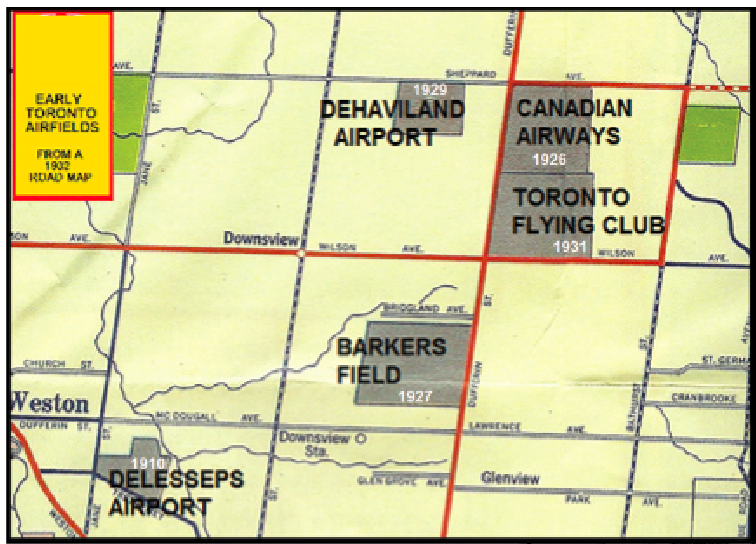 By Howard Moscoe
By Howard Moscoe An important spin off from the First World War was the growth of civil aviation in Downsview. One of the first Toronto airports was Delesseps, established in 1910 onTrethewy Drive in Weston. By the 1920s there were a number of private airfields scattered throughout the area north-west of Toronto. It was an area of large farms that were close enough to the city to be easily accessible.In 1927, Barker’s field (named after Canadian flying ace Billy Barker) opened on Dufferin Street (presently the site of Katz’s Deli). This was followed by the Toronto Flying Club in 1931 (Wilson subway station and TTC yards). The Toronto Flying Club was the principle customs entry point for out of country aircrafts until Malton Airport opened in 1939.Delesseps airport was the site of de Havilland Aircraft (UK) where a factory was established in 1928 to build airplanes. The plant moved to a 70 acre site on the south side of Sheppard Avenue between Dufferin and Keele Streets in August of 1929, Downsview Airport.During World War II, the plant was expanded with factory and test flight buildings built along the railway tracks and Sheppard Avenue. The Railway line was an important part of the Aircraft industry. ManyDeHavilland workers settled north of Toronto around Bradford and commuted daily to a station near the plant.Ironically, today that commuter function is being revived.
An important spin off from the First World War was the growth of civil aviation in Downsview. One of the first Toronto airports was Delesseps, established in 1910 onTrethewy Drive in Weston. By the 1920s there were a number of private airfields scattered throughout the area north-west of Toronto. It was an area of large farms that were close enough to the city to be easily accessible.In 1927, Barker’s field (named after Canadian flying ace Billy Barker) opened on Dufferin Street (presently the site of Katz’s Deli). This was followed by the Toronto Flying Club in 1931 (Wilson subway station and TTC yards). The Toronto Flying Club was the principle customs entry point for out of country aircrafts until Malton Airport opened in 1939.Delesseps airport was the site of de Havilland Aircraft (UK) where a factory was established in 1928 to build airplanes. The plant moved to a 70 acre site on the south side of Sheppard Avenue between Dufferin and Keele Streets in August of 1929, Downsview Airport.During World War II, the plant was expanded with factory and test flight buildings built along the railway tracks and Sheppard Avenue. The Railway line was an important part of the Aircraft industry. ManyDeHavilland workers settled north of Toronto around Bradford and commuted daily to a station near the plant.Ironically, today that commuter function is being revived. A commuter rail station is being constructed next to the new Downsview Park Subway Station Just South of Chesswood. It will allow GO commuters to transfer onto the Yonge-University subway line and take thousands of York Region cars off the streets.During WWII, Downsview airport was so busy that a set of traffic signals were installed on Wilson Heights Boulevard so that North/South automobile traffic would stop to allow planes to land on the East-West runway.Downsview owes a lot of its history to the air industry. In celebration of that, when the Downsview Subway Station was constructed it was designed around an aircraft. A design with the station’s bus terminal shaped as an aircraft wing that projects over the exterior bus bays.Even though the airbase has been closed the airport remains a major influence. The runway is essential to the operation of the Bombardier plant which continues to be a major job generator for Toronto. That runway’s flight contours dictate the height and design of buildings in the area. For example, nothing can be built on the Yorkdale Shopping centre sight higher than 45 feet which is the exact height of the office building on the east side of the mall.The Aircraft industry has not only dominated Downsview’s past but it also has a firm hold on its future.
A commuter rail station is being constructed next to the new Downsview Park Subway Station Just South of Chesswood. It will allow GO commuters to transfer onto the Yonge-University subway line and take thousands of York Region cars off the streets.During WWII, Downsview airport was so busy that a set of traffic signals were installed on Wilson Heights Boulevard so that North/South automobile traffic would stop to allow planes to land on the East-West runway.Downsview owes a lot of its history to the air industry. In celebration of that, when the Downsview Subway Station was constructed it was designed around an aircraft. A design with the station’s bus terminal shaped as an aircraft wing that projects over the exterior bus bays.Even though the airbase has been closed the airport remains a major influence. The runway is essential to the operation of the Bombardier plant which continues to be a major job generator for Toronto. That runway’s flight contours dictate the height and design of buildings in the area. For example, nothing can be built on the Yorkdale Shopping centre sight higher than 45 feet which is the exact height of the office building on the east side of the mall.The Aircraft industry has not only dominated Downsview’s past but it also has a firm hold on its future.
2 Champagne Drive - Unit C9
Toronto, Ontario, M3J 0K2
(647) 478-8752
The Voice of Downsview
Your Custom Text Here
